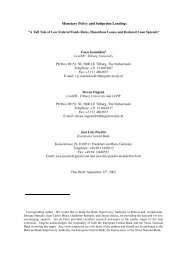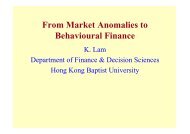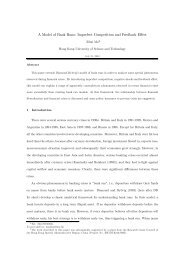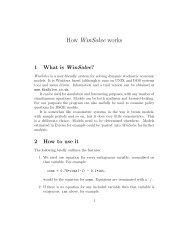Macroeconomics of the Franco-Prussian War Indemnity
Macroeconomics of the Franco-Prussian War Indemnity
Macroeconomics of the Franco-Prussian War Indemnity
Create successful ePaper yourself
Turn your PDF publications into a flip-book with our unique Google optimized e-Paper software.
Hong Kong Institute for Monetary Research<br />
trade, and so focused on <strong>the</strong> adjustment <strong>of</strong> <strong>the</strong> relative price <strong>of</strong> non-traded goods. Obstfeld and Rog<strong>of</strong>f<br />
(1996) discussed <strong>the</strong> transfer problem in a model <strong>of</strong> transport costs and non-traded goods, and argued<br />
that this framework supports Keynes’ view <strong>of</strong> <strong>the</strong> effects <strong>of</strong> a transfer. Obstfeld and Rog<strong>of</strong>f (1995)<br />
emphasized a different mechanism, coming from <strong>the</strong> wealth-induced expansion in labour supply resulting<br />
from a transfer, which leads to a terms <strong>of</strong> trade deterioration for <strong>the</strong> donor. Both <strong>of</strong> <strong>the</strong>se latter mechanisms<br />
are integral to our dynamic model below.<br />
The original commentators on <strong>the</strong> transfer problem, such as Rueff (1929), emphasized <strong>the</strong> role <strong>of</strong> <strong>the</strong><br />
terms <strong>of</strong> trade, so we adopt a two-country model and make that endogenous. Ritschl (1998) used Keynesian<br />
import equations to empirically study <strong>the</strong> effects <strong>of</strong> credit constraints implied by <strong>the</strong> Young Plan on Germany<br />
after 1929. White (2001) studied <strong>the</strong> reparations paid by France after <strong>the</strong> Napoleonic <strong>War</strong>s from <strong>the</strong><br />
perspective <strong>of</strong> <strong>the</strong> intertemporal approach to <strong>the</strong> current account. He concluded that consumption was<br />
smoo<strong>the</strong>d through international borrowing, but not by as much as predicted by <strong>the</strong>ory. He also used a<br />
neoclassical growth model to estimate <strong>the</strong> costs <strong>of</strong> various ways <strong>of</strong> financing that transfer.<br />
Finally, this work also is part <strong>of</strong> more general research on <strong>the</strong> determination <strong>of</strong> <strong>the</strong> terms <strong>of</strong> trade and <strong>the</strong><br />
real exchange rate. Lane and Milesi-Ferretti’s (2000) empirical work suggests links between external<br />
liabilities and <strong>the</strong> real exchange rate. Our empirical work seeks to isolate <strong>the</strong> effects <strong>of</strong> a specific shock —<br />
like reparations — to net foreign assets.<br />
As mentioned in <strong>the</strong> introduction, empirical work on <strong>the</strong> transfer problem is rare. But two studies have<br />
estimated some <strong>of</strong> <strong>the</strong> effects <strong>of</strong> <strong>the</strong> <strong>Franco</strong>-<strong>Prussian</strong> <strong>War</strong> indemnity. Levy-Leboyer and Bourguignon<br />
(1990, pp 243-247) studied <strong>the</strong> effects <strong>of</strong> both <strong>the</strong> war and <strong>the</strong> indemnity by adjusting and simulating an<br />
estimated, econometric model. Gavin (1992) suggested that consumption smoothing (<strong>the</strong> intertemporal<br />
approach to <strong>the</strong> current account) was relevant, but did not formally apply that approach. He used trends<br />
to gauge <strong>the</strong> effects <strong>of</strong> <strong>the</strong> transfer on French and German saving and investment during <strong>the</strong> 1870s.<br />
3. The <strong>Franco</strong>-<strong>Prussian</strong> <strong>War</strong> <strong>Indemnity</strong><br />
This transfer is an ideal candidate for study. It was virtually a lump sum, was <strong>of</strong> a large scale, was<br />
successfully made, and was largely free <strong>of</strong> default risk. The transfer took place in an environment <strong>of</strong><br />
relatively free international capital markets. Data on <strong>the</strong> terms <strong>of</strong> trade and on macroeconomic aggregates<br />
are available for France and some <strong>of</strong> its trading partners for this period.<br />
After <strong>the</strong> <strong>Franco</strong>-<strong>Prussian</strong> <strong>War</strong>, France owed Germany an indemnity <strong>of</strong> 5 billion francs. Under <strong>the</strong> Treaty<br />
<strong>of</strong> Frankfurt, France agreed to pay this amount by 1 March 1875. Appendix A to this paper contains <strong>the</strong><br />
relevant article <strong>of</strong> <strong>the</strong> treaty. In fact, most <strong>of</strong> <strong>the</strong> money was raised through two domestic bond issues in<br />
1871 and 1872, which were heavily over-subscribed. Payment was complete during 1873. As Kindleberger<br />
(1993, p 245) noted:<br />
Particularly noteworthy in <strong>the</strong> light <strong>of</strong> <strong>the</strong> subsequent transfer problem with German<br />
reparations after World <strong>War</strong> I was that with no Keynes to tell <strong>the</strong>m that transfer was<br />
impossible, <strong>the</strong> recycling and subsequent real transfer took place without any banker,<br />
economist, or government <strong>of</strong>ficial giving thought to <strong>the</strong> question <strong>of</strong> whe<strong>the</strong>r <strong>the</strong> transfer<br />
was feasible.<br />
3








